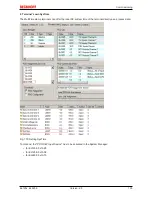
Commissioning
EL125x, EL2258
131
Version: 2.5
Fig. 165: Output in +24 V continuous mode
2. Setting the multi-timestamping factor (MTSF)
To facilitate choosing an appropriate MTSF one should estimate how many switching orders per cycle are to
be output. The multi-timestamping factor (MTSF) can then be selected. The factor indicates the maximum
number of events that can be loaded into the buffer for each EtherCAT cycle.
In order to avoid the transfer of excessive quantities of process data, the following configuration
recommendation applies:
MTSF ≥ expected maximum number of switching orders per EtherCAT cycle
Example:
At a cycle time of 1 ms, a maximum of 5 switching orders/ms per channel are expected. All 8
channels of the EL2258 are to be used.
- MTSF = 5
- Select "Multi-Timestamping 8 Ch. 5x" via the predefined PDO.
Fig. 166: Process data selection (predefined PDO) for synchronous transfer
For each switching order an output bit in the output array (right-justified) and a timestamp are available.
These process data are placeholders for the switching orders from the PLC to the channel.
If fewer channels are required, predefined PDOs are also available for 4, 2 or 1 channel(s), with an MTSF of
1x, 2x, 5x and 10x respectively.
3. How are the outputs with timestamp activated?
Procedure during each cycle:
- Place all switching orders calculated in the PLC
(output state+timestamp[32 bit])
in the PDO
- Set
NoOfOutputEvents
= x (e.g. x=5 if 5 valid switching orders are sent, x must be <= MTSF)
- Increment
OutputOrderCounter
(+ 1). This is the instruction that forces the channel to accept switching
orders.
The channel returns
OutputOrderFeedback
=
OutputOrderCounter
, once it has accepted the switching
orders. This is already the case in the next EtherCAT cycle, as long as the macrocycle time was not violated.
Therefore two application types are possible:
- Like with a handshake, the PLC always waits to ascertain whether in the next cycle the channel has
responded with
OutputOrderFeedback
=
OutputOrderCounter
before sending the next set of switching
orders. This reduces the number of switching orders that can be executed per second by 50%.
- The PLC does not wait, but continuously sends new switching orders to the channel in each cycle.
Nevertheless, it is advisable to check
OutputOrderFeedback
=
OutputOrderCounter
in order to ascertain
whether a set of switching orders may already have been accepted in the next cycle.
If no new switching orders are to be sent to the channel during a cycle,
OutputOrderCounter
should simply
be left unchanged.
It is recommended to always use (signed) 64-bit times in the PLC. The lower half this time variable can then
simply be mapped to the channel PDO. However, note that timestamps/switching orders calculated in the
PLC in this way must not be more than approx. 2 seconds in the future.
















































